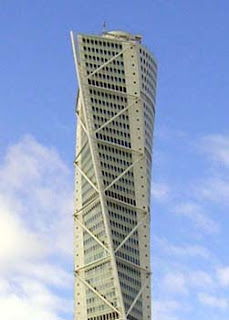Santiago Calatrava
Turning Torso
Malmö, Sweden
The 190 meter tall concrete and steel tower turns 90 degrees from bottom to top.
Designed for a prominent urban site on the occasion of the European Housing Expo 2001, Calatrava's residential tower for Malmö, at the city's West Harbor, is based in form on his sculpture Turning Torso.
Conceived to enhance and enlarge a public area, defined by the intersection of two main roads, the “Turning Torso” building is meant to be seen as a free-standing sculptural element posed within the cityscape.
In the original sculpture of Turning Torso, seven cubes are set around a steel support to produce a spiral structure, which resembles a twisting human spine.
Drawing courtesy Santiago Calatrava
In the Turning Torso building, the spiralling tower is composed of nine box units, each of five floors. The equivalent in the tower of the sculpture's steel support is the nucleus of internal elevators and stairs, through which the box units communicate.
All the apartments have unique layouts depending on their position in the building. The living rooms are large and open, often with views in two directions. The impression of light and space is reinforced by the elevated ceiling in the livingrooms.
The large, slightly tilted windows give the apartments a generous flow of natural light and fantastic views of Malmø, and Copenhagen across the Øresund Strait.
Image courtesy HSB Malmø
Photo courtesy HSB Malmø
The 53rd and 54th floor, with magnificent 360-degree views, will have conference facilities driven by HSB Malmö under the name of “Torso Meeting.” The interior, including the artwork, is also designed by Santiago Calatrava, who visited the raw space in August.
The framework consists of the core, shaped like a concrete pipe. Inside the core a concrete construction houses lift shafts and staircases.
The structural slabs, shaped like slices of a pie that are fitted together to form an entire floor, are anchored in the core. Each floor is rotated to create the characteristic twist of the building.
The facade is curved aluminum panels, with windows leaning either inwards or outwards, in order to follow the twist of the building.
An exoskeleton around the building’s front face is made of tapered white steel tubes. Following the concrete perimeter column, the exoskeleton’s single upright is fixed to the tower between each module with horizontal and inclined tubes. These tubes reach back to steel anchors embedded in shear walls at the building’s back corners.
While the spine column takes perimeter vertical loads, the exoskeleton around it provides wind resistance and dampens the building’s vibrations.



 asd
asd

.jpg)










 Posted in:
Posted in: 

0 التعليقات:
Post a Comment